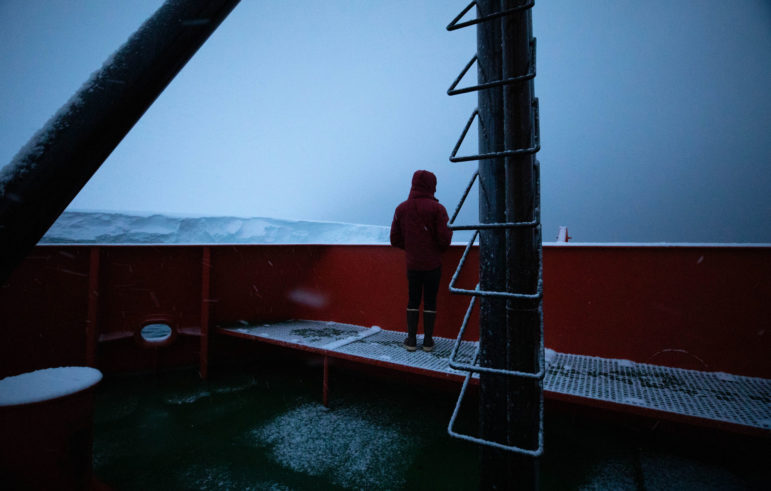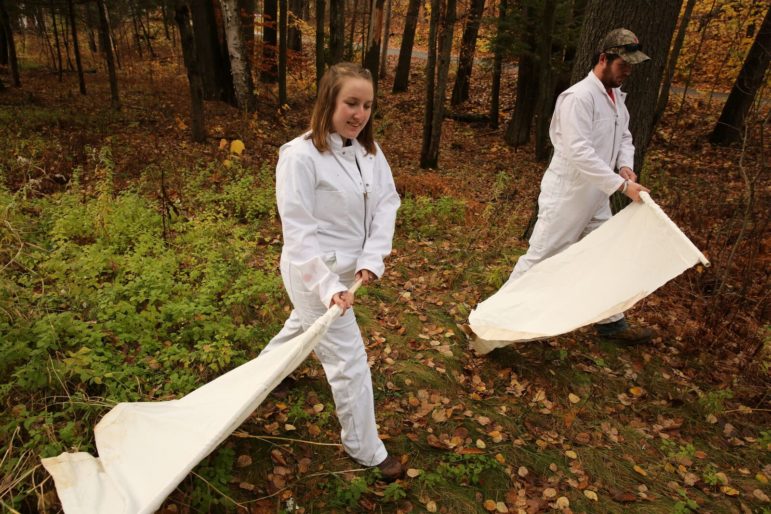After a three-year investigation provoked by InsideClimate News reporting, the New York attorney general put ExxonMobil on trial for investor fraud. ICN’s continuing coverage of the case showed what it means for the future of climate change accountability and what’s at stake for energy companies. Read the Story »
Bay Nature magazine, part of Bay Nature Institute, showed how the $17 billion agricultural industry in California’s Central Valley is scrambling to adapt to warmer winters, more erratic weather, and an imminent end to unfettered groundwater use. Read the Story »
Scalawag reported on how the climate crisis is already uprooting people from their communities, and the first wave of climate migrants are public housing residents and other poor, disabled, elderly, and vulnerable people. The story in collaboration with Environmental Health News focused on New Bern, North Carolina, a refuge for free black people before the Civil War and home still to their descendants. In the aftermath of Hurricane Florence, the city is tearing down public housing, forcing people to relocate because redevelopment and moving residents into other affordable housing nearby could take years. Read the Story »
A reporter for The World from PRI & PRX was one of only two journalists invited to spend seven weeks on board the Nathaniel B. Palmer, a research vessel bound for the Thwaites Glacier in Antarctica. Carolyn Beeler’s dispatches explained the implications of the melting of the massive glacier, which could add 1 to 2 feet of global sea level rise in the next 50 to 100 years. Listen to the Story »

Oceanographer Peter Sheehan looks out at Thwaites from the bow of the Nathaniel B. Palmer before sunrise on the day of arrival. Photo credit: Carolyn Beeler/The World
Reporting by Threshold revealed how climate change and climate change solutions are disrupting the traditional way of life for a Sámi reindeer herding family in Northern Norway. Warming temperatures are making it more difficult for reindeer to find food and a proposed wind farm threatens to disturb the herd even more. Caught in the middle, the family is struggling to maintain their traditions while navigating a changing landscape. This reporting raised awareness about the mixed implications of climate change solutions. Listen to the Story »
WJCT News is producing a website called ADAPT to explore how sea level rise will affect Northeast Florida and what’s being done by local governments, the Navy and others grappling with protecting everything from endangered species to drinking water, coastal economies and historic sites. Read the Stories »
The Intercept published a wide-ranging report exposing how the plastics industry promotes recycling as an environmental panacea while fighting against redemption laws that are proven to reduce waste. Following publication, PepsiCo and Coca-Cola announced they would be leaving the Plastics Industry Association. Congressional sponsors of a reform bill cited the reporting. Read the Story »
Honolulu Civil Beat experimented with different storytelling models and engagement strategies to get people in Hawaii really thinking about what climate change means to them personally in this yearlong “Hawai 2040” series. The series producers have been invited to speak at various public forums and share their videos, especially drone footage that shows the effects of climate change and sea level rise in Hawaii. Read the Stories »

We’ve heard about the deteriorating status of roads and bridges, but H2O Radio reports that there's another looming infrastructure crisis that’s getting little to no attention‚ and it will eventually impact everyone: America’s reservoirs are filling up with sediment. Their storage capacity peaked in the 1980s and it has been going downhill ever since‚ sometimes with disastrous consequences. Read the Story »
Reporting by the Chesapeake Bay Journal showed how climate change is threatening farmland on the Bay’s Eastern Shore, as the rising sea level pushes saltwater into fields and creates “dead soil.” The National Oceanic and Atmospheric Administration cited the Journal’s work in a climate change report. Read the Story »
PublicSource, in partnership with Environmental Health News, revealed southwestern Pennsylvania has widespread contamination from PFAS, chemicals formerly used in Teflon, Scotchguard and firefighting foam. The reporters have taken public officials to task with questions about how they will mitigate contamination—concentrated around military bases, airports and factories—and protect public health. Read the Story »
Aspen Journalism published the capstone story in a multiyear investigation of whether the City of Aspen would maintain water rights tied to a potential 155-foot-tall dam within view of one of Colorado's most scenic peaks, the Maroon Bells. Explaining how a complex, difficult-to-cover case was resolved in state water court, the story said the city agreed to seek to build dams and reservoirs in less environmentally sensitive areas. Read the Story »

Photo credit: Brent Gardner-Smith/Aspen Journalism
An ecoRI News examination of planning and environmental enforcement along Providence’s industrial waterfront showed how Rhode Island’s environmental agency, city officials, and ProvPort, which represents business interests, deflect blame onto each other for the pollution that adversely affects nearby neighborhoods. The lack of leadership endangers an area that is particularly vulnerable to extreme weather and sea-level rise. Read the Story »
The Narwhal uncovered plans by Alberta’s energy regulator to automate and expedite the process of approving new drilling, even as concerns mount about well cleanup. The Narwhal’s investigation showed the industry-funded corporation solely responsible for overseeing the province’s oil and gas industry made plans to approve the vast majority of well applications in as little as 15 minutes, with no human oversight. Read the Story »
The inaugural story at the Virginia Center for Investigative Journalism introduced readers to one of the largest environmental disasters in Virginia history. For more than 40 years, the military trained with toxic firefighting foam at many of the state's bases. The reporting revealed that the Navy had been dumping thousands of gallons of PFAS chemicals into the tributaries around the Chesapeake Bay, a prime regional source of seafood. Read the Story »
A three-part series from Connecticut Health I-Team put the longstanding problem of sewage overflows into waterways onto the Legislature’s agenda. Focusing on three areas where sewage was affecting recreation, businesses and residents, the reporting used state documents to show how much and how often untreated waste overflowed or was diverted from treatment plants. Residents have volunteered their time, their boats and money to help gather water samples for a larger study, hoping to persuade lawmakers to accelerate upgrades. Read the Story »
In a five-part series, Yale Environment 360 explored the strains that rapid growth in the Southwest, climate change and an unrelenting 19-year drought have placed on the Colorado River. The stories explain the strategies and restoration programs essential to saving access to Colorado water for the people and industries that depend on the river. Read the Stories »

Photo credit: Ted Wood/Yale e360
Mongabay investigated and confirmed a rumor that an Indonesian dam building company had forged the signature of a scientific expert on its environmental impact statement for a project that would submerge the best remaining habitat of a newly discovered and endangered orangutan species. The public outcry included protests outside regional offices of the Bank of China, which reconsidered its financial support of the $1.6 billion hydropower project. Read the Story »
Delaware Currents explored the causes and cures of a phenomenon affecting fish in the Delaware River: low levels of dissolved oxygen, which is what fish breathe. Atlantic sturgeon, an endangered species, has returned to the Delaware River where they spawn but their young are not thriving. The culprit is human waste —especially ammonia — not completely processed by wastewater treatments plants. They're not breaking the law, and treating that ammonia will be expensive. Read the Stories »
Columbia Insight focused attention on innovative ways we can reduce waste at a time when Americans are sending almost 1.5 trillion pounds of trash to landfills every day. One story showed how a project at the nation’s fourth-largest landfill, in Roosevelt, Washington, was producing compressed natural gas, turning a byproduct of garbage into a viable fuel source. Read the Story »
The Nevada Independent investigated a long-stalled state plan to clean up contamination from copper mining that tainted water supplies with arsenic and uranium on the Yerington Paiute Tribe’s historic land. The story explained how ownership changes and shifting regulatory authority left Nevada with a multimillion-dollar unfunded liability. Read the Story »
Adirondack Explorer showed how warming temperatures have resulted in the emergence of ticks in a region that had not seen them in the past, while at the same time New York State eliminated funding for tick research in the 6-million-acre Adirondack Park. Read the Story »

Students from Paul Smith's College in Paul Smith's, New York, demonstrate the tick-searching technique they use in the field. Photo credit: Mike Lynch/ Adirondack Explorer